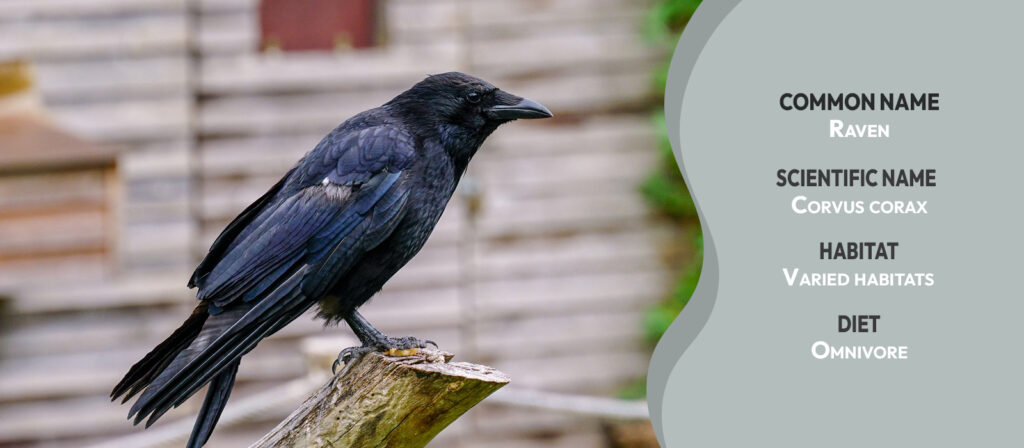
amazing Facts ABout the crow
Introduction
In the world of birds, one species stands out as a symbol of intelligence, adaptability, and mystery: the crow. With its sleek black feathers and piercing gaze, the crow has long captured the human imagination, appearing in folklore, mythology, and even as a harbinger of omens. But there’s so much more to these enigmatic avians than meets the eye. Join us on a journey into the fascinating realm of crow facts, where we’ll uncover the remarkable abilities, complex social structures, and surprising behaviors that make crows some of the most intriguing and misunderstood birds in the animal kingdom. From their problem-solving prowess to their intricate communication, crows are true avian marvels waiting to be explored.
Fact 1: Facial recognition of The Crow
Crows are renowned for their intelligence, and their capacity for facial recognition stands out as one of their most intriguing cognitive skills. Research has shown that these remarkable birds can not only distinguish between different human faces but also remember them for a remarkably long time.
In various experiments, crows were trained to associate human faces with positive or negative experiences. For instance, researchers would wear masks while capturing crows for banding. Crows that were released unharmed remembered the faces of their captors and exhibited caution when encountering them again. Remarkably, this recognition could last for several years.
This ability to remember and differentiate between individual human faces serves crows well in the wild. It helps them identify potential threats and sources of food. Furthermore, it underscores the complexity of their social interactions, as they live in tightly-knit family groups and often cooperate with one another.
Fact 2: Crows Hold Funerals
Crows are not just highly intelligent; they also exhibit complex and often mysterious social behaviors. Among these behaviors is the remarkable phenomenon of crow funerals. When a crow dies, whether due to natural causes, predation, or accidents, nearby crows often gather around the deceased bird.
During these gatherings, the attending crows display behaviors that are suggestive of mourning and respect. They may vocalize in a subdued manner, create a circle around the deceased bird, and sometimes even touch or peck gently at the body. These actions are seen as a form of collective acknowledgment and may serve various purposes, such as learning about potential threats or reinforcing social bonds within the group.
Research into crow funerals has shown that the behavior is not limited to the immediate family group but can extend to neighboring crows that were not directly related to the deceased. This suggests a level of empathy and community among crows that is quite remarkable in the animal kingdom.

Fact 3: Crows Use Tools
Crows are renowned for their intelligence, and one of the most captivating demonstrations of their mental prowess is their proficiency with tools. These clever birds have been observed using a wide range of objects as tools to access food or solve complex problems.
For example, crows have been seen fashioning sticks into hooks to extract insects from tree bark. They’ve also been observed dropping nuts onto roads, waiting for passing cars to crack them open, and retrieving the exposed nut once the traffic clears. These behaviors indicate not only foresight and planning but also an understanding of cause and effect.
Crows have even been known to use their own feathers or leaves as tools to extract food from hard-to-reach places. This tool-making and usage ability showcases their problem-solving skills and highlights their adaptability in various environments.
Furthermore, researchers have found that crows can also learn from each other and innovate with tools, passing down knowledge from generation to generation. This cultural transmission of tool use is a remarkable testament to their ability to adapt and thrive in a rapidly changing world.
Fact 4: Rare Breeding Habits
While crows may be commonly associated with urban environments and cityscapes, they exhibit fascinating behaviors when it comes to reproducing and raising their young. Here are some captivating facts about crow breeding:
Monogamous Pairs: Crows are typically monogamous and form long-term breeding pairs. These couples often stay together for many years, sometimes for life. Their commitment to one another is evident in their cooperative efforts during nesting and chick-rearing.
Cooperative Nesting: Crow parents work together to build and maintain their nests. They select a suitable nesting site, usually in a tall tree, and construct a sturdy nest made of twigs, branches, and other materials. Both partners participate in nest building, with the male providing most of the materials while the female arranges them.
Extended Family Help: In some cases, older siblings from previous years may assist in caring for their younger siblings. This cooperative breeding behavior can enhance the survival rate of the nestlings.
Nurturing Parents: Crow parents are attentive and dedicated to their chicks. They take turns incubating the eggs and feeding the hungry nestlings. Young crows, known as fledglings, stay with their parents for several weeks after leaving the nest, learning essential skills for survival.
Territorial Defense: Crows vigorously defend their nesting territories from potential threats, including other birds and animals. They engage in mobbing behavior, where multiple crows gang up on intruders to drive them away.
Conclusion
By delving into the lives, behaviors, and habitats of animals, we gain insight into the delicate balance of ecosystems and the vital roles these creatures play. Whether you’re interested in the intelligence of dolphins, the grace of big cats, or the resilience of desert insects, there is a captivating world waiting to be explored.
Each animal has its own unique story to tell, and as we unravel these stories, we become stewards of the Earth’s biodiversity. So, let’s embark on a journey of discovery, one that not only enriches our knowledge but also deepens our connection to the natural world. Whether you’re a seasoned naturalist or just taking your first steps into the realm of animals, every new fact learned brings us closer to appreciating the beauty and importance of our fellow Earthlings.

